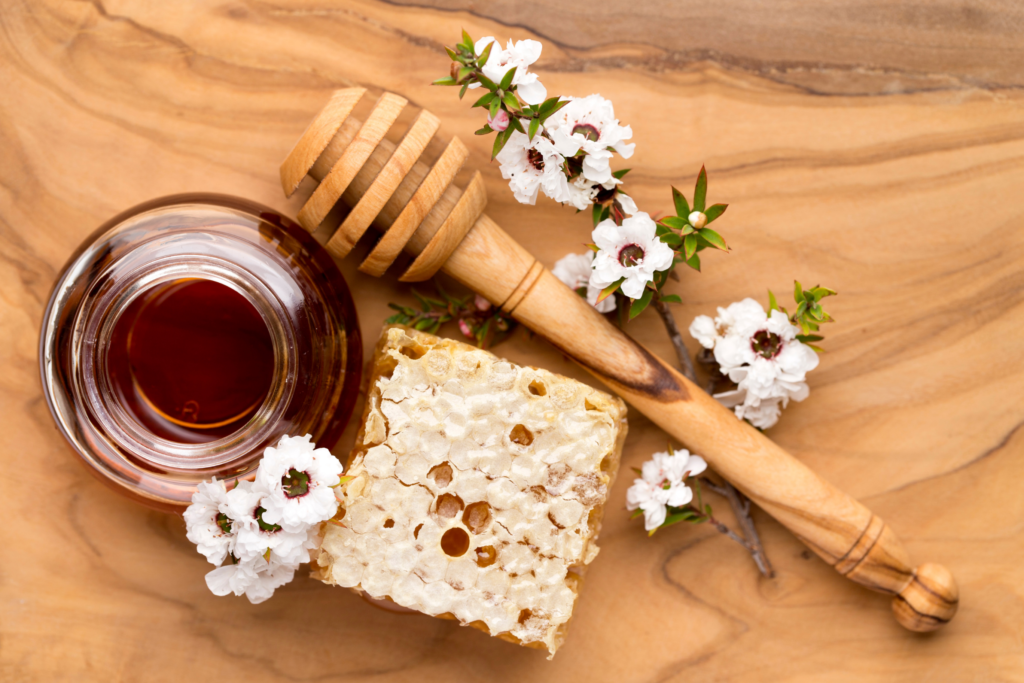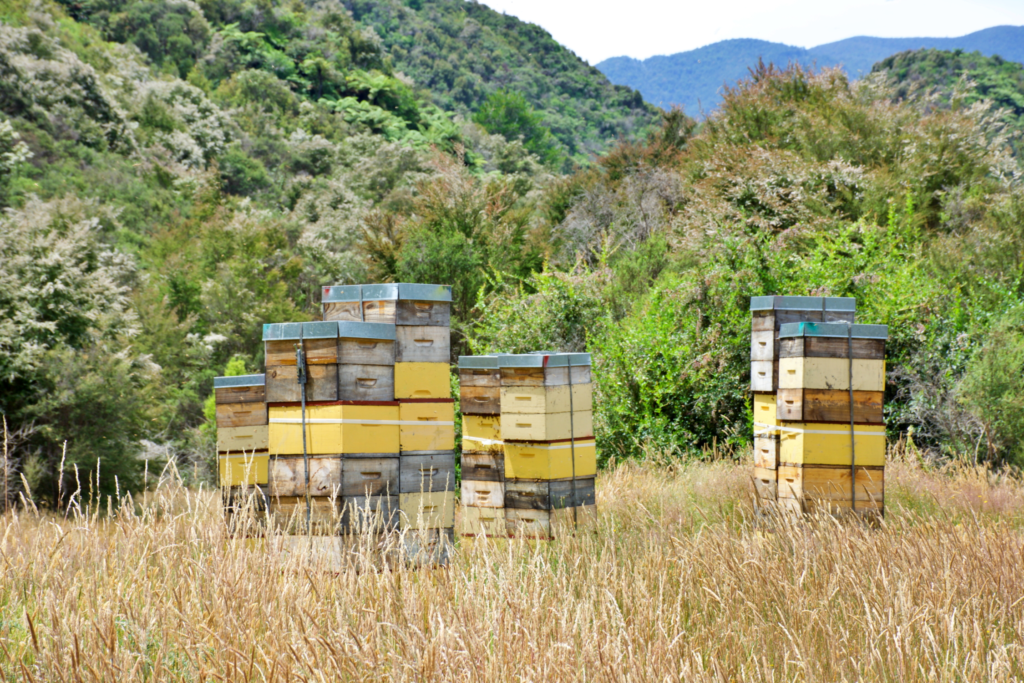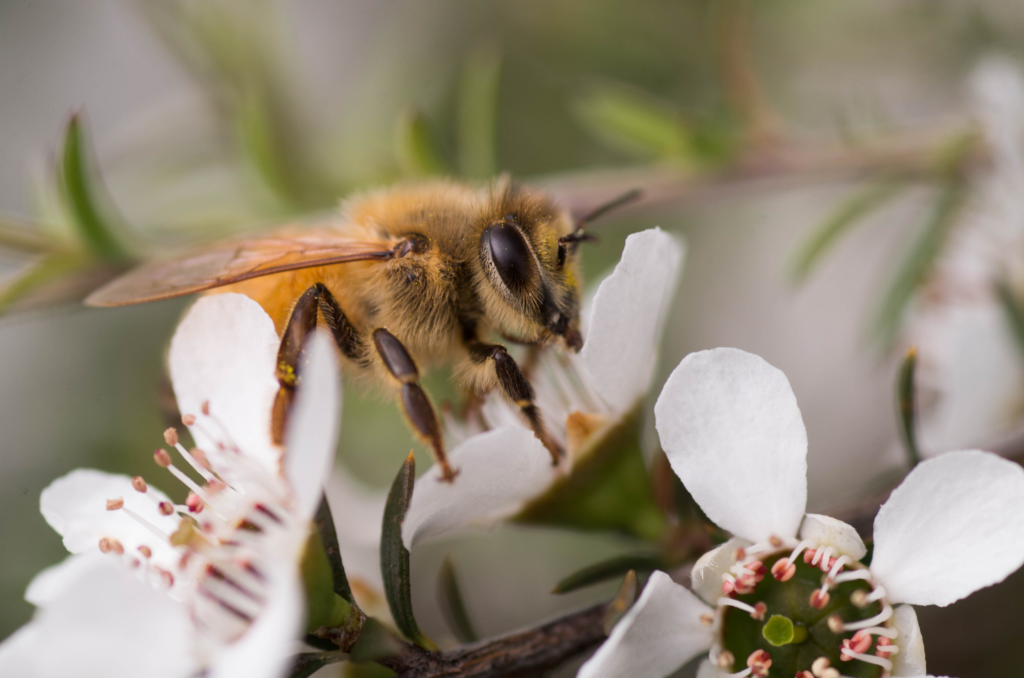Since the launch of Optimel Mānuka Honey eye care products in 2015, the use of honey-based products in eye care has been gaining momentum and creating a buzz.
Honey has been documented for medicinal uses for centuries. It has been used to treat a range of ailments including wounds, infections, eye diseases, and gastrointestinal problems. It is only more recently that we are able to understand why. The strongest research is around the antimicrobial properties of honey. It also contains many amino acids, vitamins, minerals and enzymes.
The composition of honey differs depending on the type of pollen collected by the bees. Mānuka honey, made primarily from pollen collected from Mānuka trees, has increased antimicrobial properties compared to other honey. This is due to a higher concentration of the antibacterial compound methylglyoxal (MGO).
How Does Honey Help the Eye?
Dry eye is an inflammatory condition causing swollen surfaces of the eyes and eyelids. There can also be increased numbers of bacteria on the eyelids causing increased irritation and inflammation even in the absence of infections. Honey has anti-inflammatory properties which can help reduce these symptoms.
People with meibomian gland disorder or tear deficiencies have an overgrowth of ocular flora (micro-organisms). By reducing the amount of Colony Forming Units (CFUs) through the natural antibacterial properties of honey, the bacterial enzymes which break down meibomian gland oils are also reduced. Thus improving the clinical symptoms of dry eye.
Honey based products can be beneficial in treating ocular based pathogens. With a rise in antibiotic-resistant ocular pathogens, the efficacy of other antibiotic regimes is being reduced. However as the product isn’t a drug or steroid, but a natural antibiotic, it has shown to be a natural and safe antibiotic with no literature reporting bacterial resistance. Making practitioners and patients happier about using it long term.

What are the honey based eye care products?
These eye care products contain Mānuka Honey which is derived from flowering Leptospermum scoparium (Mānuka trees). This is the most widely used therapeutic honey due to its high antibacterial properties. There are two products currently available. Both were developed in Australia but trialled by both Australian and Kiwi clinicians.
Optimel Antibacterial Manuka Eye Gel
- 98 per cent Leptospermum spp. Honey.
- Preservative free
Optimel Manuka + Dry Eye Drops
- 16 per cent Leptospermum spp. Honey.
- Preserved with benzoic acid
Both products are unaffected by standard room temperatures, nor by UV light and can be safely used with other eye drops such as those used for dry eye treatment, anti-inflammatories, anti-glaucoma medications and anti-microbial medications.
If you are interested in trying these products then talk to your eye care professional about the best way for you. One effective plan is using the gel before bed and the drops throughout the day.
And there is a third product not yet available in NZ; Melcare Manuka+ Derma Care emollient cream with 16.5% manuka honey. This looks promising for treating dermatitis and eczema on the sensitive skin around the eyelids.
What do the Mānuka Honey Eye drops do?
The product reduces the signs and symptoms of dry eye. Dry eye is a condition that sounds innocuous, but it can be hard to treat and can have a significant negative impact on people’s vision and comfort. Particularly targeting the type of dry eye caused by Meibomian gland dysfunction (MGD).
The product is more effective than the use of lubricating eye drops alone, as it treats the underlying problem, not just the symptoms. Firstly, the drops stabilise the surface of the eye from dry eye symptoms such as sore or irritated eyes and eyelids. They also create a micro-environment on the surface of the eye that supports healing and prevents further damage.
There’s also a nice NZ connection, as the honey comes from bees foraging from Mānuka shrubs. A plant New Zealanders often claim as a native, when in fact it likely came from south-east Australia.
Results from one study showed both Optimel products (when used twice a day) showed a greater reduction in the symptoms and signs of MGD when compared to the current traditional treatment of using warm compresses, lid massage and preservative-free lubricants.
Optimel eye drops (16% honey) performed slightly better than the Optimel gel (98% honey) in reducing the number of bacteria (Staphylococcus epidermidis) on the eyelids and the amount of staining on the cornea. Staining, using a yellow dye (Sodium Fluorescein) is one of the ways eye care practitioners measure the dryness of your eyes. The Optimel gel was slightly better than the Optimel eye drops at improving the quality of the meibum and how easily it could come out of the glands. Meibum is an oil that is essential for preventing tear evaporation.
Temporary redness and stinging were the only negative effects of Optimel use in this study.

Why is Manuka Honey better than other honey?
Nutritionally all honey is very similar; but it is the antibacterial, anti-inflammatory, antiviral and antioxidant properties that set Mānuka honey apart. Although all honey has some of these properties; the high sugar content and low pH of honey inhibits bacterial growth. There is scientific evidence to prove that Mānuka honey has increased benefits.
The main reason for this is the increased methylglyoxal (MGO) levels found in Mānuka honey. MGO levels can be up to 100 times higher than regular honey. You will find that true Mānuka honey has either an MGO or UMF rating on it. UMF stands for Unique Mānuka Factor and tests for four main factors. This comprises of:
- Methylglyoxal (MGO sometimes also called MG) – the source of antibacterial properties and measure of potency.
- Leptosperin — a naturally occurring chemical found only in Manuka nectar.
- Dihydroxyacetone (DHA) – slowly converts to MGO over time in living honey, ensuring long lasting benefits.
- Hydroxymethylfurfural – for freshness, increased levels indicates poor storage conditions or excess heating.
You may also see some Mānuka honey labelled as monofloral or multi floral. Monofloral Mānuka honey is the purest form; it must only be collected from Mānuka flowers. This requires the hives to be in dense Mānuka forests and the pollen can only be harvested for 2-6 weeks every year when they flower. Making it difficult to get, and one of the reasons why it is quite expensive.
For honey that contains more than Mānuka but still contains high levels of Mānuka attributes, it can be called multi floral Mānuka.
Why we should protect our bees
Bees play a crucial role in our ecosystem. Pollinators such as bees help plants survive; plants that produce food, raw materials, medicines, oxygen and much more. Contributing more than $217 million to the global economy annually. Aside from the resources we harvest from pollinated plants, pollination also contributes to biodiversity, food and cover for wildlife, clean water and air. Not only are they pollinating crops but also wild and native plants as well.
Bees are one of the most numerous and efficient pollinators, on average visiting more than 2,000 flowers in one day. There are more than 20,000 bee species globally, but populations are in decline. As bee populations decline so will important food crops. As bees are responsible for pollinating almost 90 different commercially grown food crops in the U.S. alone and 35% of agricultural production overall.
How do we protect our bees?
Over the years bee populations have been declining, in recent years by the billions! This is caused by multiple factors including parasites, pesticides, monocultural farming and climate change.
So how can you help? Start by looking after the bees in your garden! This includes providing habitats free of pesticides or chemicals, but full of nectar, pollen and potential nesting sites.
Bee-friendly garden
There are easy steps you can take to make your garden more bee-friendly.
- Plant native plants and milkweed plants good for your local bee populations.
- Provide clean pesticide free water
- Cut your lawn less and let clovers and dandilions grow
- Leave some bare soil or banks of earth for bees to nest in. Or make a backyard bee hotel!
Pesticides
Some insecticides and other chemicals used in the garden are especially harmful to pollinators such as bees. Some good rules to follow to reduce harm include:
- Minimise use – enough to do it’s job but keeps bees and other pollinators safe
- Don’t spray near budding or flowering plants
- Follow rules and regulations around using neonicotinoid insecticides

If you enjoyed this blog then go check out some of our other interesting topics:
- Sleep and the Effect on your Eye Health
- Eyesight and genetics. Is there a link?
- How do hormones affect our eyes?
- How do we see: an inside look
If you have any other questions or wish to book a consultation, get in touch with the team at Wellington Eye Centre. You can call us on 0800 733 327 or complete the contact form below.

What to expect during your Laser Suitability Medical Assessment at Wellington Eye Centre

Low-Level Light Therapy for Dry Eyes

Common Medications Used in Laser Eye Surgery

Amblyopia and Laser Eye Surgery




